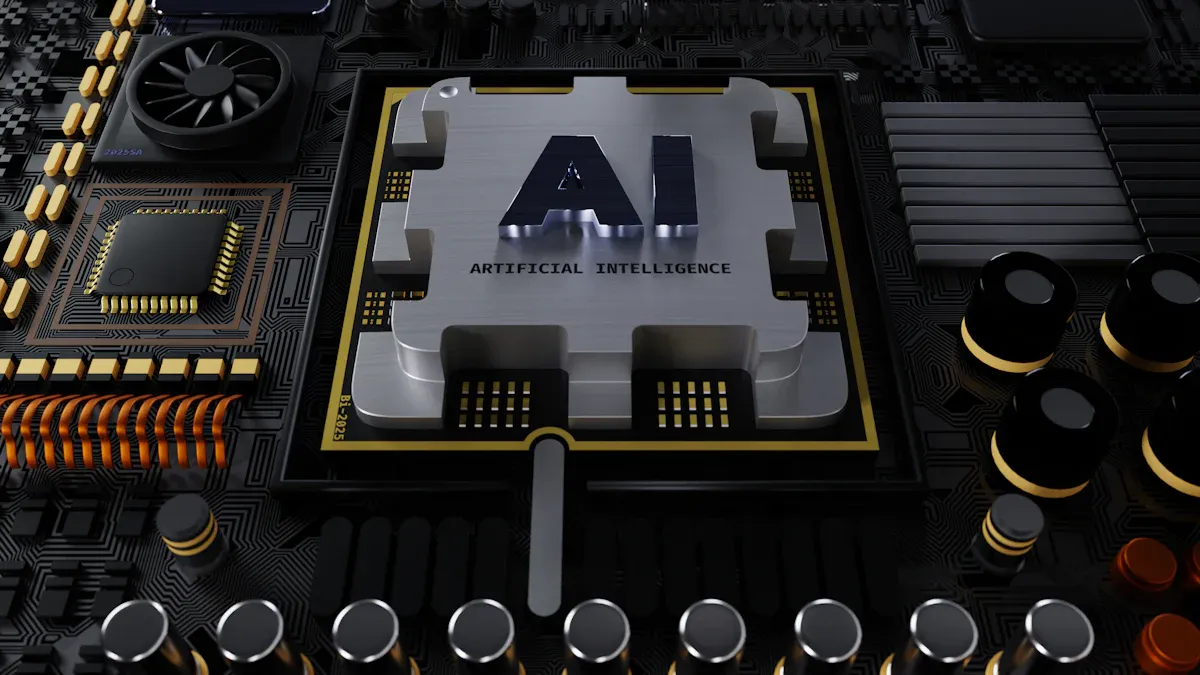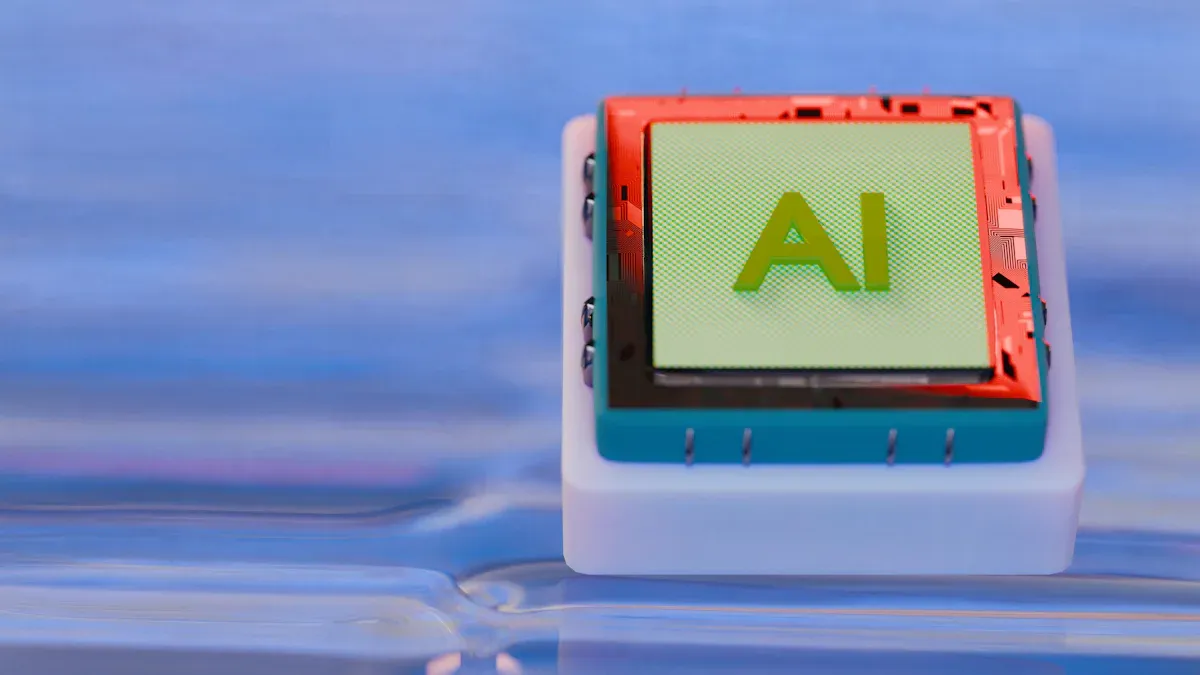What is an AI chip and how does it work in 2025

An ai chip is a specialized microchip designed to perform complex artificial intelligence tasks with high speed and efficiency. These chips use advanced architectures to process large amounts of data quickly, supporting tasks like neural processing and machine learning. In 2025, ai chips enable smarter devices and systems by handling demanding workloads such as natural language processing and data analysis. Their optimized design allows for faster computations and improved energy use compared to traditional CPUs.
Key Takeaways
AI chips are special microchips designed to handle complex AI tasks faster and use less energy than regular chips.
These chips use advanced designs like parallel processing and smart memory to speed up AI tasks such as speech recognition and image analysis.
Different types of AI chips, including GPUs, FPGAs, ASICs, and NPUs, serve unique roles to make AI work efficiently in devices from smartphones to robots.
AI chips enable real-time AI applications like autonomous vehicles and smart assistants by processing data quickly and locally.
Despite challenges like high costs and supply risks, AI chip technology keeps improving to deliver faster, smarter, and more energy-efficient AI systems.
AI Chip Basics

What Is an AI Chip
An ai chip is a microchip built to handle artificial intelligence tasks quickly and efficiently. Unlike regular computer chips, an ai chip uses special hardware to process large amounts of data at once. This design helps it solve problems like recognizing images, understanding speech, and making decisions in real time.
Key components found in ai chips in 2025 include:
Purpose-built cores such as systolic arrays, matrix engines, and tensor cores that speed up math operations needed for AI.
Heterogeneous arrays of compute units and neural processing units (NPUs) that balance speed, power use, and flexibility.
Advanced semiconductor technologies like FinFET and GAAFET transistors at sub-5nm sizes, making chips smaller and more powerful.
Special memory designs, such as processing-in-memory (PIM) and coarse-grained reconfigurable arrays (CGRAs), that help move data faster.
Integration of CPUs, GPUs, and NPUs on a single chip to handle different types of AI workloads.
Use of advanced packaging and high-bandwidth memory to support large AI models.
Manufacturers use materials like aluminum chloride, hafnium chloride, and tantalum to build these chips. They rely on precise methods such as atomic layer deposition and sputtering to create thin, reliable layers inside the chip. These steps help ai chips achieve high speed and energy efficiency.
Note: In 2025, ai chips can include up to 16 CPU cores, 40 GPU compute units, and powerful NPUs, supporting huge amounts of memory for advanced AI models.
A comparison between ai chips and traditional chips shows their differences:
Feature | AI Chips | Traditional Chips |
|---|---|---|
Design Concept | Built for AI tasks and low power use | Made for general computing |
Architecture | Uses neural network designs and matrix operations | Uses general-purpose von Neumann architecture |
Computing Power | Uses GPUs and NPUs for massive parallelism | Relies on CPUs with limited parallelism |
Energy Consumption | High computing power with lower energy use | Higher power use for AI tasks |
Flexibility | Customizable for AI functions | Programmable for many uses, less flexible for AI |
Why AI Chips Matter
Ai chips play a key role in powering modern AI systems. They allow computers and devices to learn, reason, and make decisions much faster than before. Their special design lets them perform billions of calculations at the same time, which is important for deep learning and other AI tasks.
Some reasons why ai chips matter in 2025:
They have specialized architectures that make them tens to thousands of times faster than regular CPUs for AI training and inference.
Ai chips reduce the time and cost needed to train large AI models, making advanced AI possible for more people and companies.
They use less energy by focusing only on AI tasks, which helps lower costs and protect the environment.
Ai chips support real-time applications like autonomous vehicles, robotics, and smart assistants by processing data instantly.
They enable new AI features in devices, such as better voice recognition, image analysis, and decision-making.
AI chips are essential for running large models like GPT-4o and BERT, which regular CPUs cannot handle efficiently.
The global market for ai chips is expected to reach about $166.9 billion in 2025. This growth comes from the rising use of AI in industries like healthcare, finance, and retail. As AI models get bigger and more complex, the need for faster and more efficient ai chips will continue to grow.
How AI Chips Work
Architecture
The architecture of an ai chip shapes how it handles complex tasks. Designers use several advanced features to make these chips fast and efficient:
Specialized hardware, such as FPGAs and ASICs, allows the ai chip to process many tasks at the same time. This parallelism reduces the time each task takes and lowers energy use.
Dynamic Voltage and Frequency Scaling (DVFS) lets the chip adjust its power and speed based on the workload. When the chip works on lighter tasks, it uses less energy.
Memory hierarchy plays a big role. Chips use low-power SRAM, non-volatile memories like MRAM and FeRAM, and on-chip caches. These memory types help the chip move data quickly and save power.
3D stacking of memory on top of processors shortens the distance data must travel. This design boosts speed and cuts down on energy use.
Advanced semiconductor technologies, such as FinFET and Gate-All-Around (GAA) transistors at 7nm, 5nm, or even 3nm sizes, make the chip smaller and more powerful. These features reduce wasted energy and improve performance.
Neuromorphic computing, inspired by the human brain, offers a new way to process information. This approach helps the ai chip handle tasks with even greater efficiency.
Note: Hybrid architectures combine CPUs, GPUs, NPUs, and other accelerators on a single chip. This mix allows the ai chip to handle different types of AI workloads with the best possible speed and energy savings.
A table below shows how these features work together:
Feature | Benefit |
|---|---|
Specialized hardware | Faster, parallel processing |
DVFS | Lower energy use |
Memory hierarchy | Quick data access, energy saving |
3D stacking | Shorter data paths, more speed |
Advanced transistors | Smaller size, better efficiency |
Neuromorphic computing | Ultra-efficient AI tasks |
Parallel Processing
Parallel processing stands at the heart of every ai chip. This method splits big tasks into smaller parts and runs them at the same time. The chip uses many processors or cores to do this work, which makes it much faster than doing one task after another.
In AI, parallel processing helps train neural networks by dividing the workload between CPUs, GPUs, and NPUs. GPUs, with thousands of cores, handle tough math operations like matrix calculations. This setup cuts down training time and allows real-time data analysis. For example, self-driving cars and voice assistants rely on this speed to make quick decisions.
Industry experts say that deep learning depends on parallel processing. Many neurons in a neural network can work at once, thanks to the chip’s design. Companies like Nvidia use this approach to boost performance far beyond what older chips could do.
Parallel processing and distributed computing are essential for managing AI workloads in 2025.
GPUs, TPUs, and NPUs lead the way in handling deep learning and complex AI tasks.
Frameworks like TensorFlow and Apache Spark help spread tasks across different processors, making the most of parallelism.
Specialized hardware integration ensures the ai chip can meet the demands of large datasets and complex algorithms.
Parallel processing lets the ai chip perform billions of calculations at once. This power supports real-time applications and makes advanced AI possible in everyday devices.
AI Chip Types
GPUs
GPUs, or Graphics Processing Units, started as chips for computer graphics. Today, they play a big role in AI systems. GPUs have thousands of small cores that work together. This design helps them handle many tasks at once. In 2025, GPUs train large AI models and run deep learning programs. They use special parts called tensor cores to speed up math operations. High memory bandwidth lets GPUs move data quickly, which is important for big AI projects. Companies use GPUs for tasks like image recognition, language translation, and real-time video analysis.
Tip: GPUs are popular because they are easy to program and work well for many types of AI workloads.
Feature | GPU Advantage in AI Workloads |
|---|---|
Parallel Processing | Thousands of cores for fast training |
Tensor Cores | Boost deep learning performance |
Memory Bandwidth | Quick data transfer for large datasets |
Mixed-Precision Support | Faster computation with less memory |
FPGAs
FPGAs, or Field-Programmable Gate Arrays, are chips that users can reprogram for different tasks. This flexibility makes them useful for changing AI needs. FPGAs can create custom data paths, which helps with real-time AI jobs like self-driving cars. They use less power than GPUs for some tasks and work well in places where energy use matters. FPGAs also handle many tasks at once, making them good for quick decisions in factories or hospitals. Many industries, such as automotive, aerospace, and healthcare, use FPGAs for their reliable and adaptable performance.
FPGAs support real-time AI by processing data with low delay.
They can be updated to match new AI models without replacing the hardware.
ASICs
ASICs, or Application-Specific Integrated Circuits, are custom-built chips for certain AI jobs. Designers make ASICs to do one thing very well, such as running a specific AI model. These chips use less power and work faster than general-purpose chips. For example, Google’s TPU is an ASIC made for deep learning. ASICs are not flexible, but they offer top performance and energy savings for tasks like voice recognition or self-driving cars. Companies choose ASICs when they need the best speed and lowest power use for a single job.
Chip Type | Optimization | Performance | Power Efficiency | Flexibility |
|---|---|---|---|---|
ASICs | Custom-built | Highest | Best | Low |
GPUs | General-purpose | High | Moderate | High |
FPGAs | Reconfigurable | Moderate | Good | High |
NPUs
NPUs, or Neural Processing Units, are chips made just for AI and machine learning. They have many small cores that handle math for neural networks. NPUs work well for tasks like object detection, speech recognition, and video editing. Many smartphones and laptops now have NPUs inside. These chips let devices run AI tasks locally, which means faster results and better privacy. NPUs use less energy and help devices work longer on battery power. Companies like Apple and Qualcomm put NPUs in their processors to support smart features in everyday gadgets.
NPUs speed up AI by running neural network tasks quickly and efficiently.
They help devices process data without sending it to the cloud, reducing delays and saving bandwidth.
Note: An ai chip can combine CPUs, GPUs, and NPUs to handle different AI workloads in one device.
Applications and Trends

Real-World Uses
AI chips power many advanced technologies in 2025. Generative AI uses these chips to create images, music, and text in real time. Edge AI brings intelligence to devices like cameras, sensors, and robots. These devices process data locally, which removes delays from sending information to the cloud. Paul Williamson from Arm explains that edge AI chips help robots make fast decisions. This is important for autonomous vehicles, surgical robots, and disaster-response robots. For example, Deep Robotics' quadrupeds can move through dangerous places, while Under Control Robotics' humanoid robots work in tough industrial settings.
Nvidia’s Jetson and Blackwell Ultra platforms allow robots and vehicles to sense, decide, and act quickly. These platforms support real-time AI in healthcare, manufacturing, and smart cities. Intel’s AI accelerators improve how robots learn and adapt. Audi uses autonomous robots with edge analytics to check car quality and boost efficiency. The combination of AI chips, sensors, and edge computing makes robots smarter and more helpful in daily life.
AI chips enable real-time decisions, making autonomous vehicles safer and robots more reliable in critical tasks.
2025 Challenges
AI chip development faces several challenges in 2025:
High costs make it hard for many companies to access the latest AI technology.
Training large AI models needs weeks of computation and millions of dollars.
Most advanced chip manufacturing happens in a few countries, such as the U.S., Taiwan, and South Korea.
Export controls and global competition, especially with China, create risks for supply and innovation.
Complex supply chains depend on a small number of suppliers, which can cause delays.
Balancing innovation with safe and ethical AI use remains a major concern.
Trends show that companies use AI-powered tools to design chips that use less energy and work faster. Manufacturers like TSMC, Intel, and Samsung use AI to predict equipment needs and avoid shortages. New chip designs, such as 3D stacking and chiplets, help lower energy use in data centers. Data centers now use advanced cooling and renewable energy to reduce their environmental impact. Regulators ask companies to track energy use, pushing for more efficient AI systems. Some companies invest in new power sources, like nuclear and hydrogen, to support future AI growth.
Challenge | Trend/Response |
|---|---|
High cost | Automated chip design, better efficiency |
Supply chain risks | Geographic diversification |
Energy use | Efficient chip designs, new cooling |
Geopolitical tensions | Local manufacturing, export controls |
AI chips power advanced AI systems in 2025 by delivering fast, efficient processing for complex tasks. These chips stand out with features like parallel processing, energy-saving designs, and support for real-time applications. Leading companies now create new architectures, such as NVIDIA’s Blackwell and Google’s custom CPUs, to boost performance and efficiency. Future ai chip technology will focus on even greater speed, lower energy use, and smarter devices. Readers can expect rapid changes as companies push the limits of AI hardware.
FAQ
What makes an AI chip different from a regular computer chip?
AI chips use special designs for fast math and data tasks. They process many things at once. Regular chips handle general jobs. AI chips help devices learn and make decisions quickly.
Tip: AI chips often include extra parts like NPUs or tensor cores for better performance.
Can AI chips work in smartphones and laptops?
Yes, many smartphones and laptops in 2025 have AI chips inside. These chips help with voice assistants, photo editing, and security. Devices run AI tasks faster and use less battery power.
Are AI chips safe to use in everyday devices?
AI chips follow strict safety rules. Companies test them to avoid errors. They protect user data and help devices work safely. Most devices with AI chips use encryption and privacy features.
How do AI chips help save energy?
AI chips use less power by focusing on AI tasks. They finish jobs faster, so devices do not waste energy. Many chips use smart designs like DVFS and 3D stacking to lower power use.
See Also
Understanding Computer Chips And Their Functionality Explained
Leading Advances In Medical Imaging Chips For 2025
How Communication Chips Operate And Their Key Functions
A Guide To Programmable Logic Chips And Their Operation
Breakthroughs Fueling Memory Chip Production In The U.S. 2025
